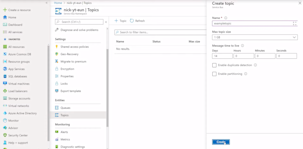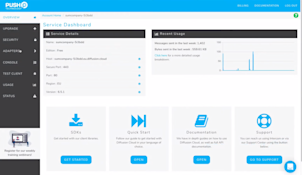Azure Service Bus vs Push Technology
This Azure Service Bus vs Push Technology comparison was created based on reviews from developers and our best attempts to perform analysis by looking at documentation and other publicly available resources.
Easily build complete, trusted realtime functionality.
Take our APIs for a spin Azure Service Bus |  Push Technology | |
|---|---|---|
| Getting started and developer experience | ||
Time to "hello world" Reviewed by 3+ independent developers Ratings were given based on the average amount of time it takes to sign up to a new account and publish the first message. | 4 / 5 5 = <30 min | 4 / 5 5 = <30 min |
Demos / Tutorials A selection of online demos and tutorials so you can test and see the code in action. Explore Ably's tutorials for our pub/sub messaging platform |
| |
Documentation Reviewed by 3+ independent developers Explore Ably's documentation for our pub/sub messaging platform | 4.33 / 5 Getting started guides / 5 Information architecture and developer journey / 5 API reference documentation / 5 Readability, design and navigation / 5 Quality of code / 5 Breadth and quality of tutorials / 5 “The resources for getting started with Azure Service Bus are thought out and clear. Documentation is pretty detailed, with sufficient examples and tutorials. The API docs are well organized around concepts and different programming languages. As a minus, some code samples are not updated with the latest constructs and data structures.“ | 3.50 / 5 Getting started guides / 5 Information architecture and developer journey / 5 API reference documentation / 5 Readability, design and navigation / 5 Quality of code / 5 Breadth and quality of tutorials / 5 “Push Technology documentation for its Diffusion product consists of several components. First, we have a quick start guide, which is pretty decent. It’s structured to provide step-by-step guidance on how to set up Diffusion and use the APIs and the SDKs. The screen is split so that you can look at documentation and code snippets in parallel - a nice touch. Then, there’s an online manual, which is significantly more detailed, with code snippets throughout. Unfortunately, there aren’t any details in the guide about the quality of service or how to architect for scalability. There’s a detailed API reference for each SDK and comprehensive release notes. The design could be improved, as it’s a bit dry, and so could the navigation experience - some links return 404, and the various sections of the documentation aren’t cross-linked. There are just a few demos available, with no source code and only several tutorials.“ |
Dashboard or dev console Reviewed by 3+ independent developers Sign up for free and explore Ably's pub/sub messaging platform | 4.67 / 5 Ease of use / 5 Stats and reports / 5 Functionality / 5  “The interface is really informative and filled with various types of details, stats, and graphs. For example, selecting a specific topic will show active, scheduled, and dead-letter message count. For new starters, though, it can be a little overwhelming to get the hang of it and understand all the concepts and features involved.”
| 4.67 / 5 Ease of use / 5 Stats and reports / 5 Functionality / 5  “The Service Dashboard is feature-rich, and it allows you to easily create, manage, and remove resources, configure settings, and view detailed stats, such as the number of messages, the CPU load, or the topic count. There’s also a nice section in the Dashboard that allows you to test your pipeline. The user experience is mostly intuitive, and the functionality is explained well (there are many tooltips throughout). However, the UI design could perhaps benefit from a refresh, as it’s a bit outdated.“ |
SDKs Note: Only official SDKs were taken into account. Explore Ably's 25+ SDKs for our pub/sub messaging platform | 7 SDKs Including:
| 7 SDKs Including:
|
API structure Reviewed by 3+ independent developers | 4 / 5 API consistency across SDKs / 5 Well structured / 5 Intuitive / 5 Simple / 5 “The APIs are fairly well-structured and named intuitively, with 3 categories described in detail. And while they are intuitive, it takes a bit to get familiar with the APIs as they’re not necessarily the most simple ones. You need to spend some time digging through the docs and GitHub READMEs, especially since there are some inconsistencies across SDKs.”
| 3.25 / 5 API consistency across SDKs / 5 Well structured / 5 Intuitive / 5 Simple / 5 “Diffusion APIs are consistent across SDKs in the sense that operations are performed in the same order. However, the APIs are quite complex - there are tens of classes and methods, with some different naming conventions across some of the SDKs, such as JavaScript, Java, or C, which is counter-intuitive. The API references are structured and presented differently, which is not great; at least they are detailed and thorough. There are examples for all SDKs on GitHub, which is useful.” |
 Azure Service Bus |  Push Technology |
|---|---|
| "Hello world" code example | |
| |
 Azure Service Bus |  Push Technology | |
|---|---|---|
| Realtime features | ||
Pub/Sub messaging Pub/Sub is a design pattern that lets any number of publishers (producers) push messages to channels (also known as topics). Multiple subscribers (consumers) can subscribe to a channel to consume published messages. Explore Ably's pub/sub messaging implementation | ||
Message queues A message queue is a form of asynchronous service-to-service communication. Messages are stored on a queue until they are processed. Note that each message is only consumed by one subscriber (consumer). Explore Ably's message queues implementation | ||
Presence Presence enables you to track the online and offline status of devices and end-users in real time and to store their state. Essential for chat apps and multiplayer games. Explore Ably's presence implementation | ||
Message history Message history provides a means to retrieve previously published messages. For this to be possible, message data must be stored (persisted) somewhere. Explore Ably's message history implementation | ||
Connection state recovery (stream resume) In the case of unreliable network conditions, clients may suddenly disconnect.Connection state recovery ensures that when they reconnect, the data stream resumes exactly where it left off. Explore Ably' s connection state recovery implementation | Limited Push Technology operates a recovery buffer of sent messages but if a message has been lost or is no longer in the recovery buffer the server will abort the reconnection. | |
Guaranteed message ordering Ordering ensures that messages are delivered to consumers in the same order that producers publish them. Explore Ably' s guaranteed message ordering implementation | Limited By default, Azure Service Bus cannot guarantee that messages are delivered in the order you want them to be processed by a subscriber at all times. You can theoretically force message ordering, but it comes at the expense of other features. | |
Exactly-once semantics Exactly-once is a system-wide data integrity guarantee that ensures each message is delivered to consumers exactly-once. Explore Ably' s idempotent publishing implementation | ||
Message delta compression Message delta compression enables you to only send the changes from the previous message to subscribers each time there’s an update, instead of the entire message. Useful for use cases where there is a significant degree of similarity between successive messages. Explore Ably' s message delta compression implementation | ||
Native push notifications Native push notifications can be used to deliver messages even when clients are offline. Useful for geolocation updates or news alerts. Explore Ably's push notifications implementation | ||
Webhooks Webhooks provide a mechanism to get messages and other types of events (such as clients entering or leaving channels) pushed to your servers over HTTP. Explore Ably's webhooks implementation | ||
Serverless functions A serverless function is essentially an isolated, single-purpose piece of code that is only executed when it’ triggered by an event. For example, you can use serverless functions to send a welcome message to clients when they become present on chat channels. Note that serverless functions are usually fully managed by cloud vendors. Explore Ably's serverless functions implementation | Limited Can only trigger Azure Functions. Azure Service Bus doesn’t have in-built support for other serverless platforms, such as AWS Lambda or Google Cloud Functions. | |
Built-in integrations Which popular services & systems are Azure Service Bus and Push Technology integrated with? Explore Ably's library of integrations | Webhooks
Serverless functions
Streaming
| Webhooks
Serverless functions
Streaming
|
Known limits and constraints Find out practical limits, such as the maximum message size, or the maximum number of concurrent connections. Explore the practical limits of the Ably pub/sub messaging platform | Throughput Unknown Maximum message size 256 KB for Standard tier, 1 MB for Premium tier. Maximum number of topics 10.000 for the Basic or Standard tier. The total number of topics and queues in a namespace must be less than or equal to 10.000. For the Premium tier, 1.000 per messaging unit (MU). Maximum limit is 4.000. Maximum number of concurrent connections NetMessaging: 1.000 per namespace AMQP: 5.000 per namespace | Publisher throughput Unknown Maximum message size Unknown Maximum number of topics Unlimited (only applies to Enterprise customers). Maximum number of connections Unknown |
| Supported development platforms, languages, open protocols and cloud models | ||
|---|---|---|
Development platforms & operating systems Which popular development platforms and operating systems do Azure Service Bus and Push Technology support via official SDKs? Explore the development platforms supported by Ably |
|
|
Languages Which popular programming languages do Azure Service Bus and Push Technology support via offical SDKs? Explore the programming languages supported by Ably |
|
|
Open protocols Which popular open protocols do Azure Service Bus and Push Technology support? Explore the open protocols supported by Ably |
|
|
Cloud models Which popular cloud models do Azure Service Bus and Push Technology support? |
|
|
| Global and reliable edge service | ||
|---|---|---|
Edge messaging network with latency-based routing Latency-based routing ensures that clients are always routed to the nearest datacenter and point of presence. Explore Ably's routing mechanism that mitigates network and DNS issues | ||
Multi-region data replication (message durability) Multi-region data replication (storage) protects against single points of failure and ensures message data durability. Learn how Ably ensures message durability | Limited Only available for Enterprise customers. | |
Uptime SLAs Here’s what the most common SLAs amount to in terms of downtime over a calendar year: 99.999% SLA = 5m 15s downtime per year 99.99% SLA = 52m 35s downtime per year 99.95% SLA = 4h 22m 58s downtime per year 99.9% SLA = 8h 45m 56s downtime per year 99% SLA = 3d 15h 39m 29s downtime per year Source: https://uptime.is/ | 99.9% | 99.9% |
Quality of Service What QoS guarantees do Azure Service Bus and Push Technology provide natively? Explore Ably's availability and uptime guarantees for our pub/sub messaging platform |
|
|
| Security | ||
|---|---|---|
API key authentication The simplest way to authenticate. Involves using private API keys that you can usually create and edit via a dashboard. Recommended to be used server-side, as private API keys shouldn’t be shared with untrusted parties. Explore Ably's implementation of API key authentication | ||
Token-based authentication Which popular token-based authentication mechanisms do Azure Service Bus and Push Technology support? Note that token-based authentication is usually the recommended strategy on the client-side as it provides more fine-grained access control and limits the risk of credentials being compromised. Explore Ably's implementation of token-based authentication |
|
|
Configurable rules and permissions Which types of configurable rules and permissions do Azure Service Bus and Push Technology support? Explore Ably's configurable rules and permissions |
|
|
Message encryption Which types of message encryption do Azure Service Bus and Push Technology support? Explore Ably's message encryption mechanisms |
|
|
Formal certifications Which formal certifications are Azure Service Bus and Push Technology compliant with? Explore Ably's security and compliance for our pub/sub messaging platform |
|
|
| Pricing & Support | ||
|---|---|---|
Free package What do the free packages offered by Azure Service Bus and Push Technology consist of? Explore Ably's free package for our pub/sub messaging platform | No free package | The free package includes 3 million monthly messages, 100 peak connections, unlimited topics, access to all major features and adapters, and basic support. |
Pricing model How are the Azure Service Bus and Push Technology pricing models calculated? Explore Ably's pricing model for our pub/sub messaging platform | Azure Service Bus comes in Basic, Standard, and Premium tiers. Basic tier pricing is calculated based on the number of messaging operations (any API call to Azure Service Bus) and costs $0.05 per million operations. Standard tier pricing is calculated based on: - number of messaging operations (first 13 million ops/month free, a base charge of $0.0135/hour and variable price depending on the number of ops - between $0.20 and $0.80 per million ops). - number of brokered connections (AMQP connections or HTTP calls to Service Bus) - depending on the number of connections, the price can be between $0.03 and $0.025 per connection/month. - number of hybrid connections & WCF relays. For hybrid connections, the monthly price is $9.782 per listener + a data transfer overcharge of $1/GB. As for relays, pricing is based on usage ($0.10 for every 100 relay hours) and messages ($0.01 for every 10.000 messages) Premium pricing is calculated based on hourly usage at $0.928 per hour. Please note that we have used the US as a reference point, but prices may vary by region and there are further differences based on the type of support package. | The basic pricing for the Business package starts at $49 per month. In addition, there are charges for the number of messages - $ 0.99 per million messages and for the number of connections - $ 0.01 per connection. It’s unclear how pricing is calculated for the Enterprise package. |
Enterprise package What benefits do the Azure Service Bus and Push Technology enterprise packages offer? Explore Ably's enterprise package for our pub/sub messaging platform | The Premium tier is the equivalent of an enterprise package. Key benefits
| The Enterprise package benefits include enterprise scale and performance, cross-region replication, configurable cluster size, bespoke performance tuning, bespoke packages for all sizes. |
Community Reviewed by 3+ independent developers Explore Ably's community support channel for our pub/sub messaging platform | 3 / 5 Presence on multiple channels / 5 Size and activity / 5 “The Azure community is quite large and present on multiple channels, such as Stack Overflow, Microsoft Developer Network (MSDN) forums, or Microsoft Q&A. However, when it comes specifically to Service Bus, the active community is significantly smaller - there aren’t as many topics or conversations related to Service Bus as one would expect, and sometimes questions go unanswered.” | 1 / 5 Presence on multiple channels / 5 Size and activity / 5 “Push Technology has a community forum, but there’s a very small number of posts and an even smaller number of followers (a maximum of 11 followers per forum category). Similarly, there are maybe 20 threads on Stack Overflow, and basically no community activity on GitHub. No presence on Gitter or Discourse. It’s essentially a non-existent community.” |
Support What types of support options and response times do Azure Service Bus and Push Technology offer? Explore Ably's support options for our pub/sub messaging platform | General support options Email, support ticket, phone, technical documentation, community support (e.g. forums or StackOverflow). Enterprise support The Professional Direct (ProDirect) plan includes 24/7 support, a Support API (to create & manage support tickets programmatically), and operational & architectural guidance from delivery managers. Response time Within 8 business hours for Developer customers Between 1 and 8 hours initial response time (depending on severity) for Standard and ProDirect customers. | General support options Email, web support, documentation, developer hub, phone (only for Platinum package), screenshare (Gold and Platinum packages). Enterprise support The Platinum package is the equivalent of enterprise support. It includes early access to beta features and a dedicated account manager. Response time 2 hours for Platinum package 3 hour minimum for Live Events package 24 hours for Gold package Best effort response times for the Basic package |
Disclaimer: The information presented for Azure Service Bus was last updated on 30 September 2020 and on 15 December 2020 for Push Technology. It is possible that some details may now be out of date. If you think that’s the case, please let us know so we can update them. In any case, you should not rely solely on the information presented here and must check with each provider before deciding to integrate or buy any of these two solutions.
View more comparisons
More to explore
About Ably
Ably is an enterprise-ready pub/sub messaging platform. We make it easy to efficiently design, quickly ship, and seamlessly scale critical realtime functionality delivered directly to end-users. Everyday we deliver billions of realtime messages to millions of users for thousands of companies.
Compare packages
Documentation
Rapidly build production-ready realtime capabilities with quickstart guides, realtime concepts, and full API reference.
Read the docs
Compare our tech
View more comparisons between Ably and other realtime messaging solutions and see why we are clearly the better choice.
View all comparisons





